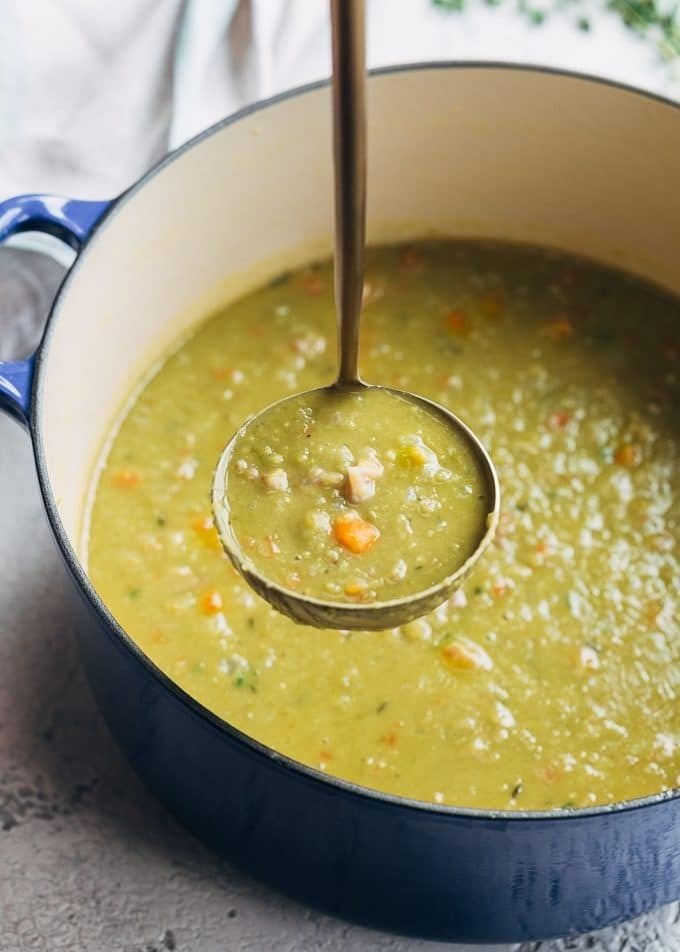Split Pea Soup
The American version of Split Pea Soup arrived with English settlers in the form of Peas Porridge.
This is a very simple, hearty soup for a chilly, rainy day especially if you have some leftover ham to eat. Pea soup has a very old lineage dating to antiquity. Greeks and Romans cultivated the seeds from the pods of the Pisum Sativum plants as early as 600 BC and there are historical accounts of vendors selling hot pea soup on the streets of Athens. The soup is mentioned in a play, The Birds, written by the Greek comic playwright, Aristophanes, in 414 BC. Today, pea soup in many forms is eaten virtually around the globe.
The American version of pea soup arrived with English settlers to the New World in the form of Pease Porridge, a thicker concoction than what eventually evolved in the 19th Century. Pea soup of those latter days was generally a puree, strained through a sieve to achieve a creamy, smooth texture.
Perhaps the most famous version of pea soup in the 20th Century was a restaurant that ultimately became known as Pea Soup Andersen’s in Buellton, California. It closed after 100 years in business at the same location, originally opened in 1924 as Andersen’s Electric Cafe. On heavily traveled Highway 101, it catered to road travelers for a century, famous for its pea soup, served in a bread bowl, along with ramekins of diced ham, crumbled bacon, shredded cheddar cheese, toasted croutons and chopped green onions. Slices of Pumpernickel and Onion Cheese Bread were also included and soup refills were free for as much as you wanted. But their peas were not, in fact, split and the soup was strained to create more of a cream of pea soup than true split pea soup. It contained no ham and the recipe was pretty basic.
This recipe like most of the current age, leaves the split peas intact. This releases their natural starches and thus, thickens the soup naturally as the peas cook, so pureeing is no longer necessary to achieve a thick, hearty soup.
Split Pea Soup

Ingredients
- 1 pound dried split peas
- 2 cups cooked ham, cubed
- 3/4 cup sweet or yellow onion, finely diced
- 1/2 cup carrots, finely minced
- 1/2 cup celery stalks, finely chopped
- 3 tsp garlic, finely minced
- 4 cups chicken stock (like, Swanson's or Kitchen Basics)
- 2 14.5-oz cans chicken broth (like, Swanson's)
- 1 cup water
- 1 tbsp dried marjoram
- 1 tbsp powdered thyme
- 2 bay leaves
- 1/2 tsp black pepper
- 1/2 tsp smoked salt (like, San Francisco Salt Company Cherry Wood)
- 3-4 tbsp olive oil for sautéing
- Toasted Croutons for topping (like, New York Bakery Season Texas Toast Croutons)
- Crumbled Bacon for topping (like, Hormel Real Crumbled Bacon)
Instructions
- In a soup pot or Dutch oven, sauté the onions, carrots and celery over medium high heat in the olive oil until the onions begin to pick up a little golden brown color, about 10 minutes.
- Add the minced garlic and sauté a minute or two more.
- Add the chicken stock, chicken broth and water.
- Stir in the split peas.
- Add the ham, the marjoram, thyme, bay leaves, salt and pepper and give the whole pot a good stir.
- Bring the soup to a strong simmer over medium high heat, then reduce the heat to low. Put a lid on the soup pot or Dutch oven and if the lid doesn't have a vent, put it on the pot askew to allow a bit of ventilation for the steam.
- Keep the soup at a light simmer for 2 to 2-1/2 hours, stirring the pot every thirty minutes or so.
- The soup is ready when the split peas semi-disintegrate and the broth thickens. Remove the bay leaves.
- Top with toasted croutons and crumbled bacon before serving.
Notes
- Unlike many other legumes, split peas do not require soaking in advance for using in a recipe.
- Like any other legume, however, the split peas must be rinsed before using in a recipe. But - and this is important - do this at the last minute before putting the split peas in the cooking pot. If you rinse the peas and allow them to sit for any length of time, the starch in the peas becomes hard and glue-like, making them stick together and requiring considerable effort to loosen and separate.

